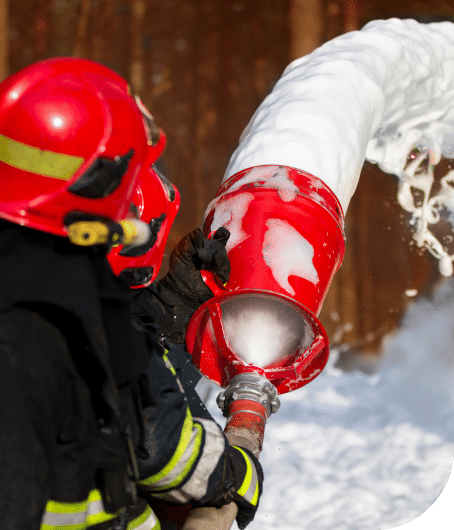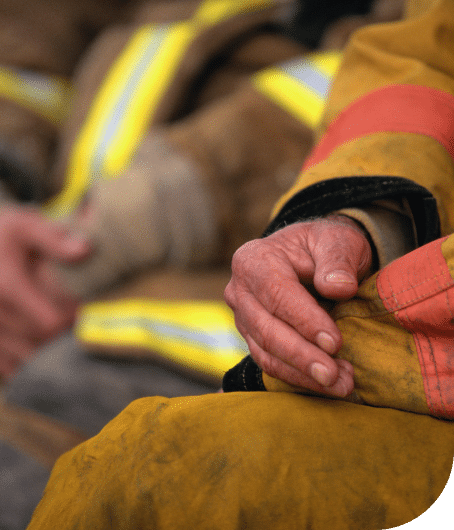PFAS Firefighting Foam
Aqueous film-forming foam is effective in extinguishing flammable liquid fires, but it is hazardous to the environment and human health. These chemicals do not break down. Humans exposed to firefighting foam may develop serious health problems, including various cancers. Firefighting foam lawsuits hold manufacturers and suppliers accountable.
Home » Practice Areas » Product Liability » PFAS Firefighting Foam Lawsuit
What is PFAS firefighting foam?
How are people exposed to PFAS firefighting foam?
Do safer alternatives for extinguishing fires exist?
Is there a class action lawsuit for firefighting foam health effects?
Who is liable for firefighting foam causing cancer?
How is liability established in firefighting foam lawsuits?
What are the allegations against the PFAS companies?
What types of compensation can I recover in a PFAS firefighting foam lawsuit?
The chemicals in PFAS firefighting foam have been linked to environmental contamination and unreasonable risks to human health. Human exposure may occur from ingestion, inhalation, or skin absorption, according to the U.S. Fire Administration. Humans may be exposed to these chemicals while fighting fires or drinking contaminated water.
If you have been harmed by PFAS firefighting foam, our product liability lawyers at The Lanier Law Firm may be able to help you recover substantial compensation.

Experience You Can Trust
Mark Lanier founded The Lanier Law Firm in 1990 with a vision to provide seriously injured individuals with personalized, skillful legal representation against large corporations. PFAS firefighting foam litigation involves large defendants such as 3M and requires the assistance of attorneys with experience in complex litigation, product liability, and environmental law.
We have built a track record of consistent, historic results in these case types, forcing corporations to change how they conduct business. Our case results include the following:
- $9 billion against the drugmakers Takeda & Eli Lilly for cancer risks associated with the diabetes drug Actos
- $4.85 billion national settlement against Merck & Company for heart attacks and sudden deaths caused by the drug Vioxx
- $4.69 billion verdict against Johnson & Johnson for asbestos in baby powder leading to ovarian cancer
- $1.85 billion opioid settlement against drugmakers on behalf of the state of Texas
Our attorneys are among the most talented trial lawyers in the nation, and we are unafraid to try cases against the largest national companies before a jury. We use unconventional means if necessary to get our clients results. We are currently in litigation against such large companies as Google and the social media company Meta.
We are also challenging large companies in the following environmental cases:
- Franklin, Indiana, water contamination
- Canoga Park and Winnetka water contamination (Los Angeles)
- Radioactive waste in Florida
- Smelter Fallout in New Jersey
- Camp Lejeune water contamination
When you entrust your case to one of our experienced attorneys, you can rest assured that we will take every available legal avenue to win you rightful compensation.
What is PFAS firefighting foam?
The Environmental Protection Agency defines PFAS chemicals as per- and poly-fluoroalkyl substances, a large group of man-made toxic organic compounds that do not break down. These chemicals, also known as “forever chemicals,” persist in the environment and accumulate over time.
According to Vanguard Fire Protection, these chemicals are virtually indestructible due to their strong fluorine-carbon bonds. They can move through water, soil, and even concrete, allowing them to seep into groundwater, which many localities nationwide access for drinking water. It can also travel in rainwater.
PFAS chemicals are the active ingredients in aqueous film-forming foam (AFFF), a highly effective product used by firefighters to extinguish class B fires.
These are fires caused by flammable liquids such as gasoline and jet fuel. It suppresses fire by forming a film that spreads across the surface of the fire and smothers it. It also prevents hot fuel from reigniting.
The specific PFAS chemicals in AFFF firefighting foam are perfluorooctane acid and perfluorooctanesulfonic acid.
How are people exposed to PFAS firefighting foam?
Exposure to the PFAS firefighting foam may occur occupationally or from drinking contaminated water. People most at risk of exposure include:
- Chemical plant workers
- First responders to car accidents
- Oil refinery and tanker workers
- Bulk fuel storage farms
- Airport workers
- Military personnel
- Firefighters
- Workers in flammable liquid storage and processing facilities
- Residents in neighborhoods where PFAS firefighting foam has contaminated water supplies
Firefighters may be exposed to PFAS firefighting foam while fighting fires, during training exercises, and in daily interactions with AFFF.

PFAS Foam Health Effects
Exposure to PFAS firefighting foam has been linked to the following adverse health effects, according to the Agency for Toxic Substances and Disease Registry:
- Increased cholesterol levels
- Decreased vaccine response in children
- Changes in liver enzymes
- Increased risk of high blood pressure or preeclampsia during pregnancy
- Decreased birth weight
- Increased risk of kidney cancer
- Increased risk of testicular cancer
- Ulcerative colitis
- Thyroid toxicity
- Neurobehavioral changes in children
- Asthma in children
According to the International Association of Fire Fighters, AFFF is also associated with an increased risk of:
- Non-Hodgkin lymphoma
- Ovarian cancer
- Prostate cancer
Do safer alternatives for extinguishing fires exist?
Fluorine-free fire-extinguishing compounds are widely available, according to Vanguard Fire Protection, and in some locations, AFFFs are banned. Fluorine-free foams are effective in extinguishing class B fires with minimal environmental impact and low toxicity.
Is there a class action lawsuit for firefighting foam health effects?
Due to the large number of lawsuits related to firefighting foam, these lawsuits have been consolidated into multidistrict litigation, or MDL. Unlike class action lawsuits, MDL cases remain separate. However, a single federal court manages them.
The PFAS firefighting foam lawsuits have been transferred to the District of South Carolina and assigned to the Honorable Richard M. Gergel. The case is “In Re: Aqueous Film-Forming Foams Products Liability Litigation,” case number 1:17-cv-01056.
As of March 16, 2023, the MDL had 4,058 lawsuits pending, and this number is growing. Cases filed in individual state or federal courts anywhere in the country will likely be transferred to the MDL. Cases already transferred to the MDL include lawsuits filed by local and state governments, individual lawsuits, and at least one class action lawsuit.

An MDL provides a more efficient means of litigating cases with similar facts without overburdening the court system. The MDL judge will preside over a few representative trials, known as bellwethers. The outcome of these trials generally influences the outcome of the remaining cases.
Ideally, the plaintiffs will prevail in the bellwether trials, triggering a global settlement with the proceeds divided among all the plaintiffs. The bellwethers could also result in individual settlements. After the bellwether trials conclude, the cases may be returned to the original courts. However, there are usually far fewer cases at this point.
Who is liable for firefighting foam causing cancer?
The AFFF defendants designed, manufactured, marketed, distributed, or sold the PFAS firefighting foam. They are numerous and include the following, though this is not an exhaustive list:
- 3m Company Agc Chemicals
- Americas, Inc.
- Archroma, U.S., Inc.
- Arkema, Inc.
- Buckeye Fire Equipment Company
- Carrier Global Corporation
- Chemguard, Inc.,
- Clariant Corporation
- Corteva, Inc.
- Dupont De Nemours, Inc.
- Dynax Corporation
- E.I. Du Pont De Nemours And Company
- Kidde Fenwal, Inc.
- National Foam, Inc.
- The Chemours Company L.L.C. F/K/A The Chemours Company
- Tyco Fire Products Lp
- UTC Fire & Security Americas Corporation, Inc.
How is liability established in firefighting foam lawsuits?
In product liability cases, the responsibility falls on the manufacturers, distributors, and retailers of a product that harmed consumers, even if the parties were not negligent. This theory of liability is known as strict liability.
To prove strict liability, you must show the defendant manufactured, distributed, supplied, marketed, or sold a product that harmed you while using it as intended. You must further prove that the product was harmful because of at least one of the following:
- An unsafe product design
- A manufacturing defect
- Failure to adequately warn or instruct
You can also sue manufacturers and suppliers on negligence grounds. Negligence requires proof that:
- The defendant owed a duty of care.
- The defendant breached the duty of care.
- An injury occurred because of the breach.
- The breach was the proximate cause of the injury.
The firefighting foam lawsuits include counts for both strict liability and negligence.
What are the allegations against the PFAS companies?
The AFFF MDL cases have similar facts, but the plaintiffs are diverse, and the allegations vary. Below are examples of the allegations asserted against the defendants.
Strict Liability
Plaintiffs are suing based on design defects and failure to warn.
Design Defects
- Plaintiffs allege that the defendants violated an implied warranty that the product was safe and fit for sale when they marketed AFFF foam.
- Plaintiffs allege that the defendants should reasonably have foreseen that the products would be used near water wells, causing surface water and groundwater contamination and the resulting damages.
- Defendants allegedly marketed an unreasonably dangerous product when used as intended, including extinguishing fires in aviation, marine, fuel, and shallow-spill applications.
- Plaintiffs allege that the manufacturers failed to provide safe alternative products, though it would have been feasible.
Failure to Warn
Plaintiffs allege that the defendants failed to provide adequate warnings of the foreseeable dangers of PFAS, preventing users from seeking safer alternatives.
Negligence
Plaintiffs allege that the defendants knew or should have known that the products were dangerous when used as intended. They assert the defendants owed the public a duty to prevent the release of PFAS in firefighting foam. However, the defendants allegedly marketed and sold the products despite the dangers without warning the public.
Trespass
The plaintiffs allege that the testing, use, and leaching into the surface water and groundwater constitute trespass because no one authorized these materials to enter the water supplies. This trespass is continuing because the contamination persists.
Due to the defendants’ alleged flagrant disregard for public safety, the plaintiffs are seeking punitive damages.
Public Nuisance
Plaintiffs allege that the defendants have created a public nuisance due to the widespread harm to public health.
What types of compensation can I recover in a PFAS firefighting foam lawsuit?
The results of the MDL bellwether trials may influence compensation in a PFAS firefighting foam lawsuit. Compensation may include the following economic and non-economic damages:
- Lost wages
- Medical expenses
- Loss of earning capacity
- Pain and suffering
Punitive damages may also be available if the plaintiffs prove the defendants deliberately or recklessly caused harm or engaged in fraudulent concealment of the potential for harm.
Workers’ Compensation
If you were exposed to PFAS foam during employment and subsequently developed cancer or another related illness, you may qualify for workers’ compensation. Workers’ compensation provides partial wage replacement and free medical care for the related illness.
Depending on your state’s laws, workers’ compensation may also be available to volunteer firefighters.
If you qualify for workers’ compensation, you cannot sue your employer, but you may be eligible to sue the manufacturers and distributors who supplied PFAS firefighting foam to your employer. If you do not qualify for workers’ compensation, you may be able to sue the employer, including a state or local government entity.
How can The Lanier Law Firm help?
As the MDL progresses, we will ensure your case is filed correctly and complies with the legal requirements throughout the proceedings. When you hire The Lanier Law Firm, you can count on us to go to work for you and fight for justice for as long as it takes to get the compensation you need and deserve.
We will apply the depth of our experience to provide you with the following:
- Fervent advocacy
- Timely case filing
- Calculation of your case value
- Aggressive settlement negotiations
- Skillful trial representation, if needed
We provide these services with no upfront costs. You won’t owe us anything until we successfully recover compensation for you.
When should I contact a lawyer?
Contacting a lawyer promptly after you are diagnosed with an illness related to your exposure to PFAS foam is critical. Each state imposes a deadline for filing a case known as the statute of limitations. These deadlines vary from state to state and may be as soon as one year after you are diagnosed with a related illness.
The initial consultation is free. Contact us today for a free case evaluation.
By submitting this form, you agree to our terms & conditions. Please read the full disclaimer



